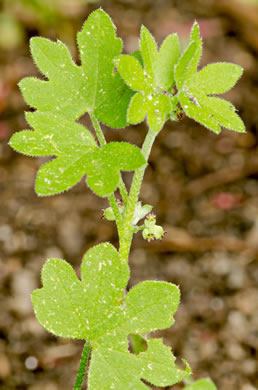Spermatophytes (seed plants): Angiosperms (flowering plants): Eudicots: Core Eudicots: Asterids: Campanulids: Apiales
WEAKLEY'S FLORA OF THE SOUTHEASTERN US (4/24/22):
Bowlesia incana
FAMILY
Apiaceae
Go to FSUS key
Dig deeper at SERNEC, a consortium of southeastern herbaria.
The native distribution of this species is uncertain, per Weakley's Flora (2022)
SYNONYMOUS WITH
PLANTS NATIONAL DATABASE:
Bowlesia incana
FAMILY
Apiaceae
SYNONYMOUS WITH Floristic Synthesis of North America. BONAP (Kartesz, 2021)
Bowlesia incana
SYNONYMOUS WITH Guide to the Vascular Plants of Florida (Wunderlin & Hansen, 2011)
Bowlesia incana
SYNONYMOUS WITH Manual of the Southeastern Flora (Small, 1933, 1938)
Bowlesia septentrionalis
COMMON NAME:
Hoary Bowlesia
To see larger pictures, click or hover over the thumbnails.
Keith Bradley kab_bowlesia_incana_2339
March Richland County SC
Olympia Park
Leaves orbicular, as wide as or wider than long, lobed but otherwise entire, per Weakley's Flora (2015).
WEAKLEY'S FLORA OF THE SOUTHEASTERN US (4/24/22):
Bowlesia incana
FAMILY
Apiaceae
SYNONYMOUS WITH
PLANTS NATIONAL DATABASE:
Bowlesia incana
FAMILY
Apiaceae
SYNONYMOUS WITH
Floristic Synthesis of North America. BONAP (Kartesz, 2021)
Bowlesia incana
SYNONYMOUS WITH
Guide to the Vascular Plants of Florida (Wunderlin & Hansen, 2011)
Bowlesia incana
SYNONYMOUS WITH
Manual of the Southeastern Flora (Small, 1933, 1938)
Bowlesia septentrionalis
If a search such as "Carex leptalea var. leptalea" doesn't deliver the results you want, try "Carex leptalea".
Or, to minimize chances of a misspelling, try just "Carex le".
Less is more: If "pencil flower" doesn't deliver the results you want, try "pencil".


